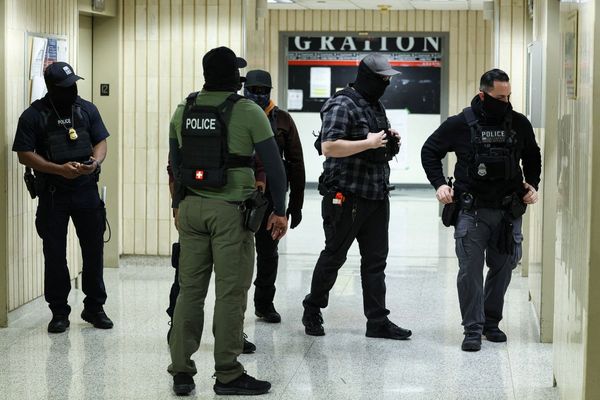7,697 dead or missing.
That’s just the number tracked by the Missing Migrants Project, launched by the International Organization for Migration, from its inception in 2014 until March 2023. There are sure to be many more — stuck in the mud of the Darien Gap, dead somewhere in Mexico along the tracks of “The Beast,” under the waters of the Caribbean or baking in the Arizona desert, at the end of a journey that began thousands of miles south, in Tegucigalpa or Caracas.
The number will only grow as more people flee hunger and violence, authoritarianism and repression. Migrants are flocking out of Haiti and Cuba, Guatemala, Honduras and Nicaragua. Between 2015 and 2020 the share of Venezuelans living outside Venezuela jumped from 2.5% to 19%. A quarter of Salvadoreans live outside El Salvador.
Last month about 1,200 people crossed the treacherous Darien per day. Every departure is a roll of the dice. The Missing Migrants Project counted 1,434 dead or disappeared in 2022, up from 1,249 in 2021 and 798 in 2020.
The death of dozens of migrants in a blaze at a detention facility in Ciudad Juarez last month has triggered rightful outrage over the Mexican authorities’ dismal treatment of powerless asylum seekers. But the tragedy was not born merely of local xenophobia or bureaucratic incompetence. It is the inevitable outcome of a political strategy north of the border that offers little but hostility or, at best, indifference to migrants fleeing across the hemisphere for their lives and dignity.
Victims, there are thousands. Strong as the political imperatives driving President Joe Biden’s border policies may be, he cannot continue to accept death as a perhaps sad but ultimately affordable consequence.
To be clear, the administration’s attempts to cope with the scrum of people massing at the border are not unreasonable. The U.S. — as any country — should be able to control who comes across. This is not easy to achieve across a border that experiences the impact of every foreign crisis, near or far — the ultimate objective of people fleeing every time something goes wrong anywhere in the hemisphere.
The carrot-and-stick approach to take pressure off the border is not crazy. Offering expanded legal paths for asylum seekers who apply online from afar while making it much more difficult to enter the U.S. for people who show up to make their case at the border could be an effective deterrent.
And the administration is not wrong to fear the political ramifications, especially given how prospective migrants reacted to the end of the Trump administration’s fire and brimstone by surging to the U.S. border in ever larger numbers, expecting a more lenient welcome. Immigrant advocates impatient with the political constraints in Congress should ponder what policy would be like in the hands of hardline Republicans campaigning on the back of a slogan about a border “out of control.”
Ultimately, the U.S. cannot stop migrants from fleeing north from their homes in Nicaragua, Haiti or Honduras. If deployed properly, however, its new policy would reduce the incentive for people to launch upon such a dangerous journey with such long odds of success. It has already yielded a drop in migrant run-ins with U.S. border agents.
Yet despite all of this, the White House cannot simply let the dead pile up while the rejiggered incentives work to deter new arrivals and eventually perhaps fix the thing.
They may well not. The Biden administration’s approach relies on Mexico accepting Venezuelans, Nicaraguans, Cubans and Haitians summarily expelled from the U.S. under the Title 42 public health emergency provision enacted during the COVID pandemic. But no deal has been announced between the U.S. and Mexico on whether and how these expulsions will continue after the provision ends in May.
The Mexican government of Andres Manuel Lopez Obrador has proven just as indifferent to migrant deaths as its peers in the Biden administration — willing to let Mexico play the role of border wall in exchange for a pass from Washington on other issues, ranging from a nationalistic energy policy that may violate trade agreements to an increasingly authoritarian governance.
But its stance rests, in part, on the understanding that Washington’s new immigration strategy will curb migrant flows across Mexico too. That may not hold for long. The U.S. is expelling some 70,000 migrants per month. While immigration is much less salient in Mexico than it is in the U.S., Lopez Obrador’s political calculations will change if voters’ opinion of migrants continue to harden.
Attitudes against immigration have been hardening throughout Latin America, as waves of migration from Venezuela, Haiti, Cuba, Nicaragua have brought a once distant topic into hard focus from Santo Domingo to Santiago. Researchers at the Inter-American Development Bank found xenophobic comments in almost a quarter of Twitter posts on issues related to migration in the region in the last quarter of last year, compared with 4% in the first quarter of 2017.
Migration policies are hardening too. The Dominican Republic is busy building a wall along its border with Haiti. Chile has deployed the military along its border with Peru and Bolivia. Mexico has deployed the national guard against migrants trying to cross its territory. Costa Rica made asylum harder to get. And countries in the region have imposed visa requirements on citizens from Venezuela, Haiti, Ecuador and others.
In a recent column, Andrew Selee of the Migration Policy Institute warned the Biden administration that its more restrictive approach to asylum seekers will reverberate across the hemisphere, opening political space for governments in Latin America to further stiffen their approaches to re-establish control over their own burgeoning immigration.
This path is likely to lead to more illegal immigration. It also leads to more dead migrants.
Dara Lind from the American Immigration Council observes that Washington’s immigration policy has been caught in Groundhog Day for decades, cycling between panic and self-congratulation depending on whether border apprehensions are up or down. To be fair, whatever the administration’s critics say, this problem is not easy to solve. Still, President Biden and his advisers must confront the real world.
Reality imposes several constraints: One, there is no such thing as an impregnable border. Two, migrants will keep coming — more than 740 a day. (So the border patrol will need a better app than CBP One to process them.) And three, keeping migrants out cannot be the only priority. Keeping them alive must rank pretty high too.
This is immediately relevant to the Biden administration’s new strategy: Proper deterrence requires convincing prospective immigrants that they will not remain in the U.S. unless they are granted asylum. But convincing them cannot come at the cost of their lives.
____
ABOUT THE WRITER
Eduardo Porter is a Bloomberg Opinion columnist covering Latin America, U.S. economic policy and immigration. He is the author of "American Poison: How Racial Hostility Destroyed Our Promise" and "The Price of Everything: Finding Method in the Madness of What Things Cost."
This column does not necessarily reflect the opinion of the editorial board or Bloomberg LP and its owners.







